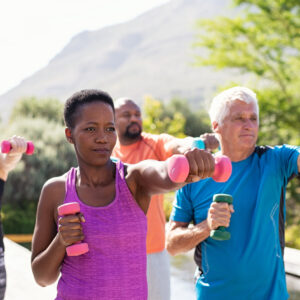Optimal Exercise: Experts Suggest Building Strength As You Age

Optimal Exercise: Experts Suggest Building Strength As You Age
February 1, 2023
There’s certainly no lack of information and advice about exercise and aging on agebuzz. Whether it’s about walking, weight lifting or just moving your body as frequently as possible, we’ve signed on to the essential wisdom that, “Exercise is the best prescription for maintaining your independence.” But is there a “best or optimal” exercise when it comes to keeping physically fit and active as you get older? Does it matter whether you do a daily walk, hit the gym twice a week, or get on the yoga mat for some online yoga sessions? While all of these activities are beneficial and will enhance your health and well-being, there is some thinking and research to suggest that paying attention to your muscles and engaging in strength training may be the most critical aspect of your exercise routine.
As you likely know by now, the CDC and other health-promoting organizations recommend a minimum of 150 minutes of moderate to intense aerobic activity each week- or 75 minutes of vigorous activity. But there’s also a recommendation that you put in 2 days of muscle-strengthening activity each week as well. In fact, exercise or activity that promotes strength is just as important as any aerobic endeavor. It might even be more important than that daily walk or game of pickleball, because strength training, which promotes and improves balance and mobility and builds muscle mass, makes all of the other activities in which you engage possible. If you don’t have strength and balance, the walk on the path or lunge on the pickleball court becomes all the more treacherous. Moreover, loss of muscle mass is a natural occurrence as we get older so it’s all the more important that we make up for that loss with focused attention on resistance and bodyweight training, which allows you to stay active and lower your risk of disability and chronic disease.
So if you’re now convinced to add a muscle-building regimen to your aerobic routine, what’s recommended? Experts consulted in a recent Washington Post article on muscle strength recommend 4-6 different exercises that engage as many muscle groups as possible (including your legs, hips, chest, abdomen, shoulders, and arms). To be more specific, both The New York Times and Live Strong have each recently featured 10-minute bodyweight workout guides that require no equipment and can be done anywhere you have a bit of space. With guidance on how to move and use your body to create resistance, these muscle-building exercises are sure to help build strength, stamina, balance, and mobility. Consumer Health Day also just featured a 5 part calisthenics routine (Calisthenics is a type of exercise that uses your own body weight as resistance to build strength and flexibility.) With visuals that show you how to squat, push up from a surface, or use your glutes and hamstrings to create a “bridge,” you’ll come to see how easy it is to move those major muscle groups, build up strength, and keep on an independent path, all without pricey equipment or a fancy gym.







